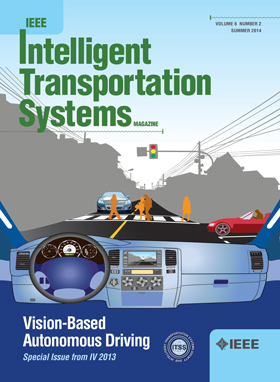Self-Supervised Visual Odometry Based on Scene Appearance-Structure Incremental Fusion
IF 8.4
1区 工程技术
Q1 ENGINEERING, CIVIL
IEEE Transactions on Intelligent Transportation Systems
Pub Date : 2025-04-21
DOI:10.1109/TITS.2025.3559077
引用次数: 0
Abstract
Self-supervised visual odometry (VO) has exhibited remarkable benefits over supervised methods, surpassing the reliance on the annotated ground-truth of training data. However, most existing self-supervised VO methods, namely scene appearance-based methods, have limitations in exploiting the complementary properties of cross-modal information between scene appearance and structure. To this end, we propose a novel self-supervised VO based on scene appearance-structure incremental fusion scheme. Specifically, a Global-Local Context awareness-based Depth estimation Network (GLC-DN) is designed to introduce the scene structural cues, thus laying the foundation for realizing the scene appearance-structure incremental fusion. Then, a Dual stream Pose estimation Network based on Scene Appearance-Structure Incremental Fusion (SASIF-DPN) is devised, which consists of a Dual Stream Network (DSN) and multiple Cross-Modal Complementary Fusion Modules (CM-CFMs). CM-CFM fully leverages the complementary properties between the RGB information and the predicted depth information, and the combination of multiple CM-CFMs facilitates the information interaction between the two modalities in an incremental fusion manner. Detailed evaluations of GLC-DN and SASIF-DPN provably confirm the effectiveness and design principles of each component we propose. Extensive comparison experiments have also been conducted, which clearly verify the superiority of our method compared to current counterparts.基于场景外观-结构增量融合的自监督视觉里程计量
与监督方法相比,自监督视觉里程计(VO)表现出了显著的优势,超越了对训练数据的注释基础真值的依赖。然而,大多数现有的自监督VO方法,即基于场景外观的方法,在利用场景外观和结构之间的跨模态信息的互补性方面存在局限性。为此,我们提出了一种基于场景外观-结构增量融合的自监督VO方案。具体而言,设计了基于全局-局部上下文感知的深度估计网络(GLC-DN),引入场景结构线索,为实现场景外观-结构增量融合奠定基础。然后,设计了基于场景外观-结构增量融合的双流姿态估计网络(SASIF-DPN),该网络由一个双流网络(DSN)和多个跨模态互补融合模块(cm - cfm)组成。CM-CFM充分利用了RGB信息与预测深度信息的互补性,多个CM-CFM的组合使两种模式之间的信息交互以增量融合的方式进行。对GLC-DN和SASIF-DPN的详细评估证实了我们提出的每个组件的有效性和设计原则。并进行了大量的对比实验,清楚地验证了我们的方法相对于现有同类方法的优越性。
本文章由计算机程序翻译,如有差异,请以英文原文为准。
求助全文
约1分钟内获得全文
求助全文
来源期刊

IEEE Transactions on Intelligent Transportation Systems
工程技术-工程:电子与电气
CiteScore
14.80
自引率
12.90%
发文量
1872
审稿时长
7.5 months
期刊介绍:
The theoretical, experimental and operational aspects of electrical and electronics engineering and information technologies as applied to Intelligent Transportation Systems (ITS). Intelligent Transportation Systems are defined as those systems utilizing synergistic technologies and systems engineering concepts to develop and improve transportation systems of all kinds. The scope of this interdisciplinary activity includes the promotion, consolidation and coordination of ITS technical activities among IEEE entities, and providing a focus for cooperative activities, both internally and externally.
 求助内容:
求助内容: 应助结果提醒方式:
应助结果提醒方式:


